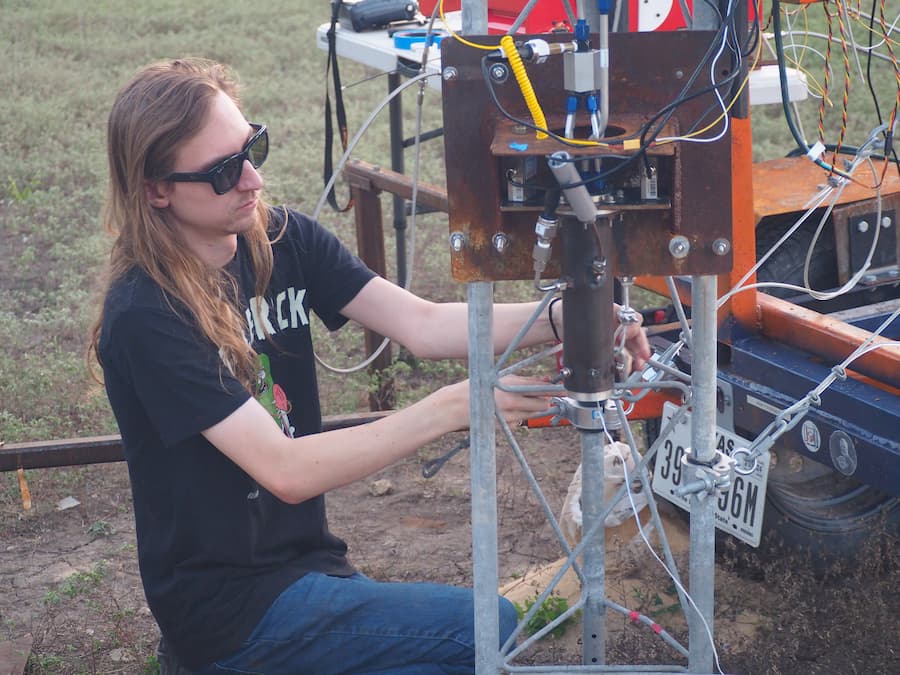Posted on October 23, 2025 by Sean M. Wood

Mechanical engineering major, Grace Zimmer, working on a component of the rocket.
League of Legends, the online game where the League of Liquids senior design team took its name has no “final boss” to defeat to win the game.
But for collegiate rocket engineering, the final boss could be designing, building and launching a bi-propellant liquid-fueled rocket. It requires a deeper understanding of fluid dynamics, thermodynamics and control systems on top of aerodynamics and mechanical engineering. That’s the challenge before senior mechanical engineering majors Grace Zimmer, Haven Russell, Emilio Mayorga and Tanner Ford.
The group is scheduled to launch their rocket, Jinx, powered by the liquid-fueled engine, Miss Fortune, in California’s Mojave Desert on Nov. 9. They have already completed two successful tests of their engine — designed and manufactured by the students themselves entirely in the Klesse Makerspace — to ensure it is generating enough thrust to take the rocket into the air. They expect to test the engine and rocket together after one more successful test of the engine.

“Right from the beginning, we said as a team we wanted three hot fires of the engine that went mostly well before we committed to integration into the flight vehicle,” Russell said.
The students are after much more than a grade for their final project. They are developing the design and troubleshooting skills and experience that will hopefully land them jobs in the space industry when they graduate in December. But this project is intended to extend beyond this semester.
Their advisor, Associate Professor Daniel I. Pineda , said he tasked students with coming up with an accessible design that can be relatively accessible and easily accomplished by college students in a typical campus machine shop.
“It’s just enough complexity to give them a level of experience that industry desires and seeks in future employees but just enough in scope for students to build and test in a single academic year,” Pineda said. “But also, with this approach, if something doesn’t work, the tests and hardware are not that expensive relative to a bigger multiyear project. It’s striking a balance with design and employers can see they have what it takes to design systems that go on their rockets and for their satellites.”
Russell had just returned from a job interview with Relativity Space in Long Beach, Calif. where team members told him nearly everyone had experience working on college rocket projects. “As Dr. P. said, having that experience is genuinely something they are looking for,” Russell said.
The work is being fully funded by Pineda who jokingly called it “Dr. Pineda’s Scholarship for Wayward Rocket Students.”
“It’s an investment,” he said. “I’m the adviser for the rocket club and these students have been active participants and team players in the club for years. They have also taken multiple courses with me and so I know their technical strengths and capabilities. You need great project management and engineering skills to pull this off. I consider this like a seed grant and once we build up momentum and get the word out there that we’re doing this at UT San Antonio we’ll get more corporate sponsorships that can support this long term.”
Many university rocket teams use solid propellant engines for their reduced complexity, for their superior ability to achieve high velocities and altitudes at the university-scale, and because there are commercial options available, although some groups mix their own solid propellant. UT San Antonio’s Aeronautics and Rocket Club (ARC) has done this before and will continue to design and build solid-propellant rockets for future competitions. Liquid propellant engines, by contrast, must be entirely custom-made. League of Liquids is making their components in the Klesse Makerspace, in part to make history, according to Zimmer.
“We want to be the first university group in Texas to launch a liquid-propellant rocket that’s student-built,” Zimmer said.
Other Texas schools have built liquid-fueled engines and had successful test-fires, according to Pineda, but he’s not aware of any university-affiliated projects that have had successful launches. He said some groups have launched hybrid rockets with liquid oxidizers and solid fuel.
“That’s not quite what we’re doing,” Pineda said. “The bi-propellant liquid architecture is most closely related to what’s used in launch vehicles in the industry, and reusable launch vehicle development is one of the biggest drivers of growth for these companies, especially those in Texas. So, we’d like to be the first group in Texas. But I don’t think a lot of people know that we’re in this race. We’re kind of like the dark horse.”

